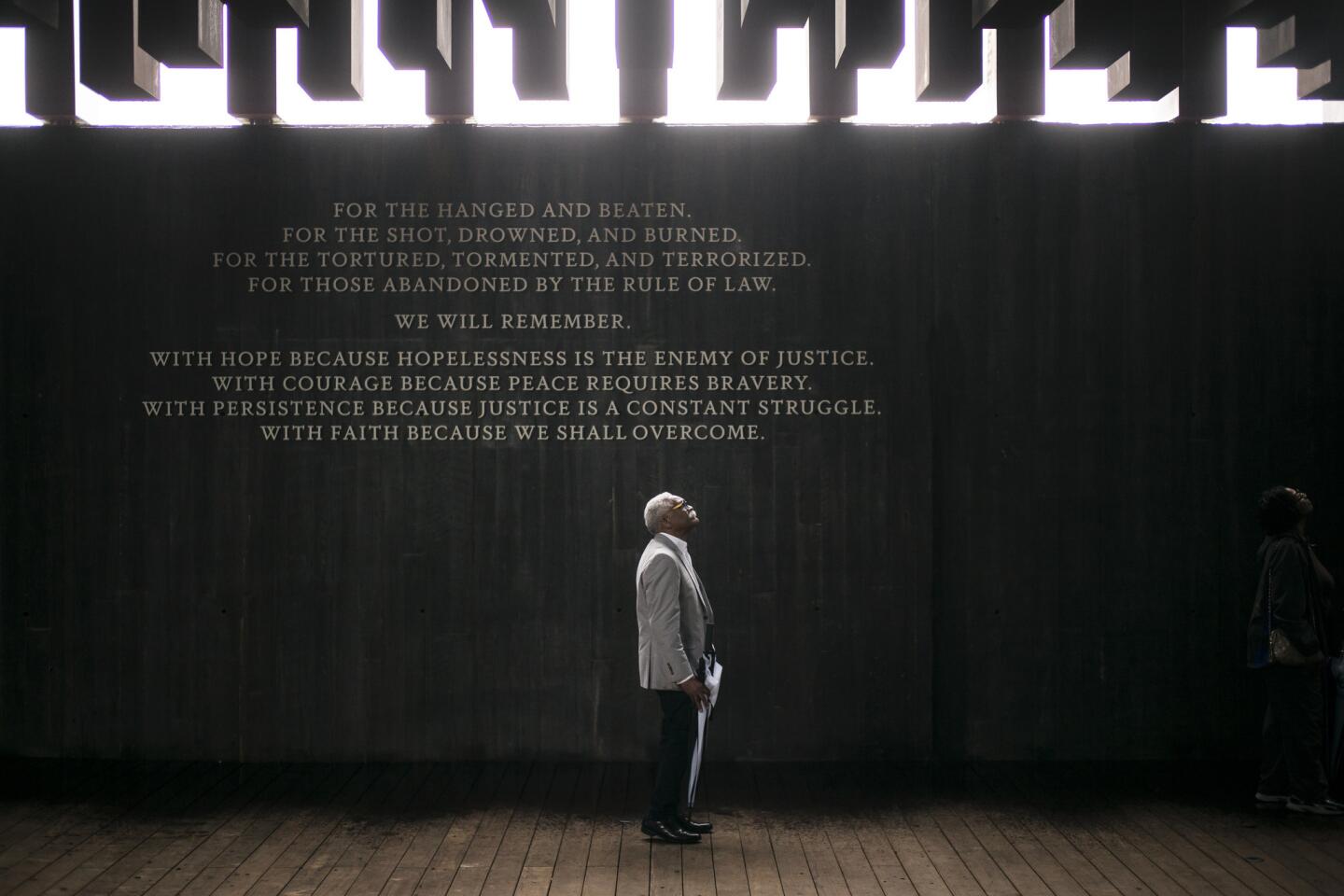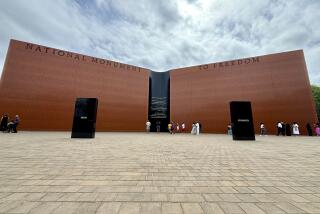Witness a history of racial injustice at two new museums in Alabama and Mississippi
Reporting from Montgomery, Ala. — Shirah Dedman burst into tears when she saw her great-grandfather’s name on a coffin-sized box and a jar of soil.
Since childhood, the Los Angeles native had heard about a relative who had been lynched. Eventually, she learned that he had been arrested in 1912 in Shreveport, La., for passing a letter to a white woman.
When the case was dismissed for lack of evidence, a crowd grabbed him at the courthouse and strung him from a tree where he was shot repeatedly. When she saw the dirt recovered from the site, his murder finally become real.
“There were so many emotions looking at that,” she said. “It was so hurtful. I was crying. I felt a lot of anger. I felt frustration. I wanted to talk. I wanted to be quiet.”
Dedman, who lives in Oakland, is one of many who have been drawn to the Legacy Museum and National Memorial for Peace and Justice, which opened this spring in Montgomery, a former capital of the Confederacy.
The site has sparked a countrywide conversation about lynching. It has also attracted crowds to what has been called the nation’s most notable monument since Maya Lin’s Vietnam Veterans Memorial, which opened in 1982 in Washington, D.C.
Only a few months earlier, neighboring Mississippi, the state with the most documented lynchings, also opened a new institution devoted to racial struggle.
The new Mississippi Civil Rights Museum in Jackson recounts the history of protests, murders and martyrs in a region that a half-century ago was the front line in the struggle for equality.
Exhibits explore the era’s flashpoints, from the race riot that followed the integration of the University of Mississippi; to the Freedom Summer murders of civil rights workers James Chaney, Michael Schwerner and Andrew Goodman, addressed in the film “Mississippi Burning”; to the assassination of civil rights activist Medgar Evers.
The $90-million state-funded museum complex, which includes a separate wing on Mississippi history, is the more comprehensive; the Montgomery site is designed to pack an emotional punch and make a political point. Together, the two sites, about 250 miles apart, complement and build on each other, providing a modern, clear-eyed view of some of the country’s darkest moments.
Alabama
The Montgomery project is largely the creation of attorney Bryan Stevenson, founder of the Equal Justice Initiative, which has worked to exonerate falsely convicted death-row prisoners.
The six-acre outdoor memorial features 800 weathered rectangular steel boxes hanging beneath an open canopy. Each box represents a county or jurisdiction with a documented lynching between 1877 and 1950 and lists the names of largely forgotten victims in each county, such as Henry Smith of Lamar County, Texas, who was accused of killing a white girl, and then tortured with hot irons and set on fire in front of a crowd of 10,000 in 1893.
There’s also Elizabeth Lawrence, lynched in Jefferson County, Ala., in 1933 after scolding children for throwing rocks. And thousands more.
The information comes from the EJI’s multiyear study that documented more than 4,000 lynchings, which the researchers call racial terror killings.
In most cases, the victims were grabbed by a mob and killed in public, usually by hanging, but also by gunshot or drowning. Sometimes it occurred in public squares, where vendors sold refreshments.
Gawkers claimed pieces of clothing or body parts as souvenirs. Occasionally, commemorative postcards were printed.
The memorial recounts these details on brief information panels, but its visual impact is visceral. At first, the markers hang at eye level, but as visitors proceed through the monument, the wooden floor slopes down.
Soon monuments are suspended above, forcing you to look up. Eventually, the memorial presents a vista of hundreds of rusted slabs hanging overhead like bodies. The visitor becomes the spectator, bearing witness to brutality.
Every marker has a replica that lies in a field outside the canopy. Each jurisdiction is invited to claim its monument to bring home for public display.
The intent is clear. “Our memorial will become a report card about which communities have owned up to their history and which haven’t,” Stevenson said.
A half-a-mile away, the EJI’s small Legacy Museum, which is built in a former slave warehouse, aims to put the memorial in context. Beginning with hologram exhibits on slavery, it argues that lynchings took place to control and terrorize African Americans after emancipation.
That legacy evolved into Jim Crow laws legalizing segregation and continues today in what Stevenson called the “mass incarceration” of African Americans.
Exhibits recount forgotten chapters of history, including the Red Summer of 1919, when race riots erupted across the country and more than 100 people were lynched.
One moving display features a jailhouse interview with Anthony Ray Hinton, who was exonerated in 2015 after 28 years on death row. Oprah Winfrey last month selected his autobiography for her book club.
Mississippi
Winfrey, a Mississippi native, was involved with that state’s civil rights museum. In the Jackson museum, she narrates a short film about the 1955 killing of Emmett Till, a 14-year-old boy visiting from Chicago who was accused of flirting with a white grocery store clerk.
A few days later, he was kidnapped, and his barbed wire-wrapped body was soon found in the Tallahatchie River.
The Justice Department recently reopened its investigation of the crime, “based upon the discovery of new information,” a Los Angeles Times article said.
“The department did not elaborate, citing the ongoing nature of the investigation,” the article said.
After Till’s death, his mother gave him an open-casket funeral, and the shocking images of his maimed body were printed in Jet magazine, launching the modern civil rights movement. The museum displays the original magazine pages, along with the doors of the Bryant’s Grocery & Meat Market.
Elsewhere, Klan robes, Confederate flags and government documents methodically and dispassionately recount the state’s combative racial history.
But the museum is hardly a collection of dusty memorabilia. It uses historic footage, interactive displays and innovative exhibits to convey its story.
One section addresses the assassination of Evers, who was shot in the back by a white supremacist. The father of three staggered to the door of his home, where his family found him bleeding to death.
The museum also celebrates the movement that ultimately eliminated legal segregation. One gallery, lined with hundreds of mugshots, honors the Freedom Riders, who arrived in Jackson by bus, train and plane to challenge the South’s segregated transportation facilities.
Other areas detail the sit-ins, read-ins, wade-ins and other protests that integrated lunch counters, libraries and public beaches.
Indeed, the sound of hope flows through the galleries. At the heart of the museum, a 40-foot light sculpture called “This Little Light of Mine” pulsates every half hour in sync with gospel-inspired songs that provided a soundtrack to protests. As more people enter the central gallery, the music plays more loudly.
Evers’ widow, Myrlie Evers-Williams, who spoke at the museum’s opening, said the symbolism is clear. “You hear the sounds of horror, but you hear the sounds of coming together,” she said.
Likewise, Stevenson said he hoped visitors would leave the Montgomery sites with a sense of optimism, not depression.
“We want everybody to understand this history. We’re not defined by it, we’re not doomed by it, but we can’t ignore it,” he said. “There’s a better America still waiting. But we can’t achieve it if we don’t tell the truth about our past.”
If you go
The National Memorial for Peace and Justice, 417 Caroline St., Montgomery, Ala. The memorial is open 9 a.m.-5 p.m. daily except Tuesdays. Tickets cost $5; children 6 and younger are admitted free.
The Legacy Museum, 115 Coosa St., Montgomery, Ala.; (334) 386-9100. The museum is open 9 a.m.-7:30 p.m. daily except Tuesdays, closing at 6 p.m. Sundays. Tickets cost $8 for adults, and $5 for students and seniors. Children 6 and younger are admitted free.
A combination ticket for the two is $10 for adults, $7 for seniors and students. Children 6 and younger are admitted free.
The Mississippi Civil Rights Museum, 222 North St., Suite 2205, Jackson, Miss.; (601) 576-6800. Open 9 a.m.-5 p.m. Tuesdays-Saturdays, 1-5 p.m. Sundays. Closed Mondays. Admission is $8 for adults, $6 for seniors 60 and older, $4 for youth 4-18. Children 3 and younger rare admitted free.
More to Read
Sign up for The Wild
We’ll help you find the best places to hike, bike and run, as well as the perfect silent spots for meditation and yoga.
You may occasionally receive promotional content from the Los Angeles Times.







